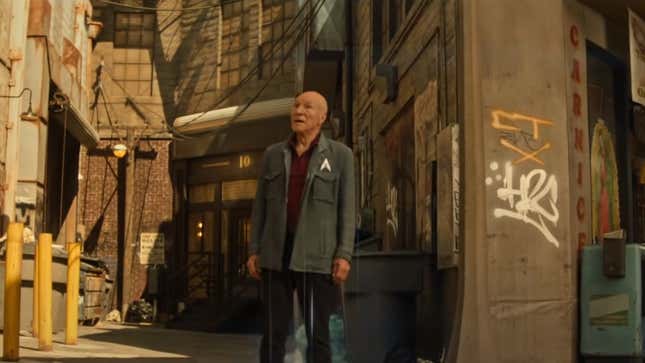
We’ve known since we got our first glimpses of it in action that Star Trek: Picard’s second season was going to delve into some time travel shenanigans. But our recent, Guinan-laden look at the season gave us a few more specifics... and told us that Picard and his friends are being thrust nearly into our own timeline, but at very different inflection point in the entire franchise’s history.
The second season two trailer revealed that part of Picard’s quest to save himself—when he’s not being harassed by Q or seemingly also being sent to a parallel reality of some sort—will see him and the crew of La Sirena flung back hundreds of years, all the way to... well, two years from now, 2024. But as mundane as that might seem to us here in the exciting 2022 times of climate change and global pandemics, in Star Trek’s universe the year 2024 might have die-hard DS9 fans’ ears burning.
Why is 2024 So Important in Star Trek?

We last visited 2024 in the Deep Space Nine season three two-parter, “Past Tense,” where Sisko, Bashir, and Dax are thrust back to the year after a transporter malfunction. Finding themselves in San Francisco where Starfleet HQ would be, but 347 years earlier than they should be, Sisko explains that the early 21st century was an incredibly dark time for America. The captain and his fellow officers find themselves on the eve of great social upheaval in the United States, in the wake of a mass protest known as the Bell Riots—named for their instigator, Gabriel Bell, who accidentally gets killed due to Sisko’s interference in the timeline, which leads to Sisko himself taking on Bell’s persona and place in history. Oops. Anyway, don’t worry about that!
The Earth of 2024 was in incredibly dire straits in the Star Trek timeline. Many countries faced violent conflict and civil unrest, but America in particular took a turn towards a totalitarian decline in the period, wracked with severe economic crises, homelessness, and rapidly rising unemployment levels. These issues saw widespread adoption across the country of “Sanctuary Districts,” walled-off city sections originally established as dedicated areas to provide free housing, food, and opportunities for employment. But the Districts very quickly became a way for police forces to brutalize and inter poor civilians, becoming run-down, barely controlled slums. With District citizens cut off from the planetary network, the majority of the American public was unaware of the mistreatment going on within them.
The Bell Riots began after a group of San Francisco’s District A residents staged a violent takeover of the district’s processing center, taking several police officers and government employees hostage. Although a peaceful solution to the crisis nearly came to fruition—largely thanks to the work of Gabriel Bell/Sisko—and local news channels started broadcasting the stories of sanctuary residents to the public, the Governor of California deployed the National Guard to District A. Hundreds of Sanctuary residents were murdered, but the public broadcast of the riots and the aftermath turned public opinion against Sanctuary Districts as a concept, laying the groundwork for social and economic reformation.
What Happened After the Bell Riots?

The Bell Riots were so important to Star Trek’s past that the possibility of them not happening created a parallel timeline where the Federation and Starfleet—and the very concept of a United Earth—never existed. But although the exposure of the terrible conditions within Sanctuary Districts led to their abolishment, the socioeconomic reforms that came about in the wake of the riots didn’t immediately set either the U.S. or the Earth at large immediately on a brighter path...
Mostly because World War 3 broke out two years later. Oops.
Already having been ravaged by the Eugenics Wars in the early ‘90s—in which 37 million people died over conflicts related to altering the human genome and genetic engineering—Earth found itself brought into nuclear conflict just decades later. Although little is detailed about the conflict across various Star Trek series, it’s known that the U.S. went to war against a pan-nation alliance known as the Eastern Coalition, or ECON, and that by its conclusion in the early 2050s, almost every major city on the planet had been wiped out, most governments had collapsed, and six hundred million people died. While Earth would take time to recover from the post-apocalyptic fallout of the conflict, first contact with the Vulcans in 2063 spurred humanity to unite after decades of tearing itself apart, rapidly spurring Earth onto the interstellar stage and laying the road for the formation of the Federation.
Suffice to say, Picard is thrusting its cast into an incredibly volatile period of human history within the Star Trek timeline by making the L.A. of 2024 a major location in season two. We’ve seen glimpses of Sanctuary Districts in the trailers, so we know that at least some of this history not touched since Deep Space Nine is going to at least be nodded towards—but just how Picard and his friends react to being thrust into one of the darkest chapters in Star Trek’s pre-Starfleet history is going to be fascinating to watch.
Wondering where our RSS feed went? You can pick the new up one here.